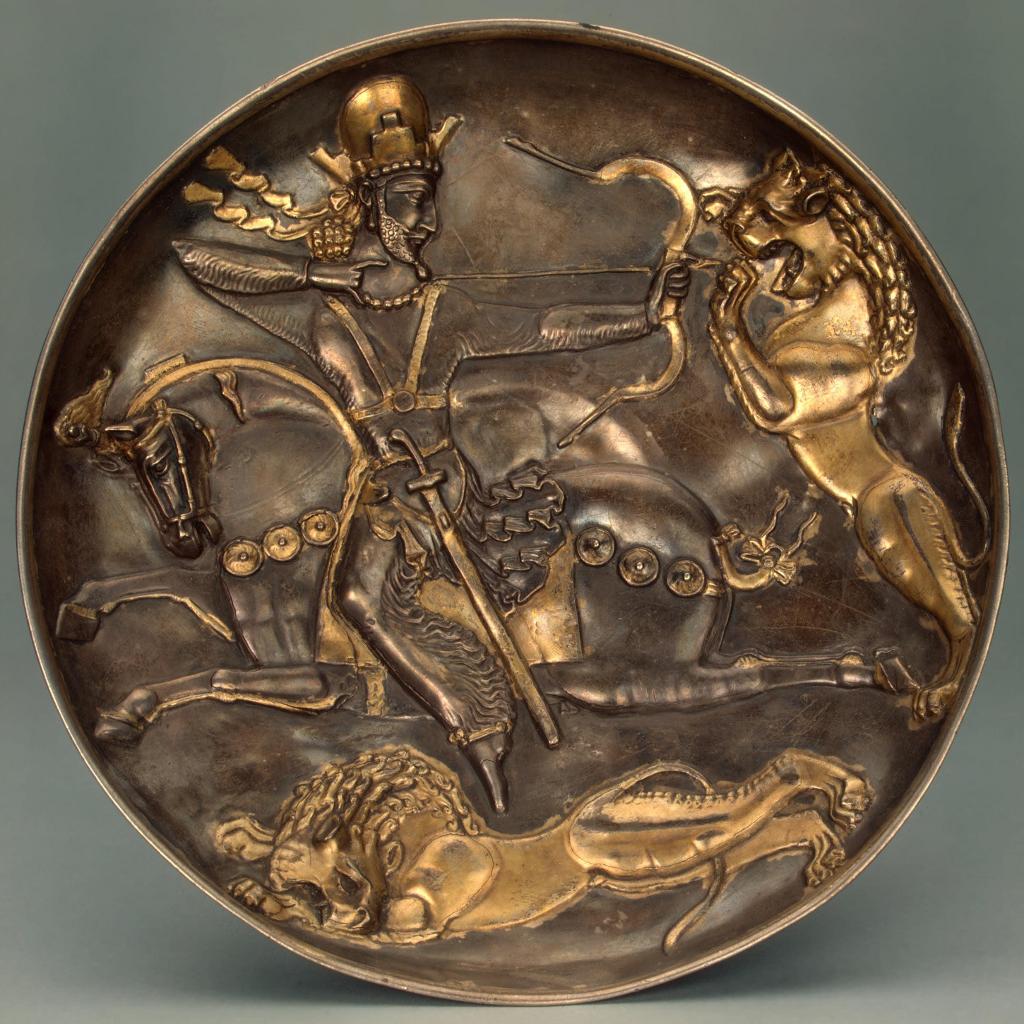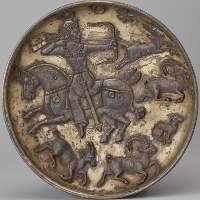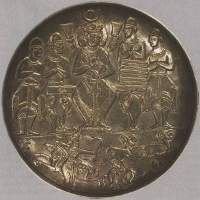|
The "Turushev Plate"
A Sasanian King Hunting Lions

A larger image of the "Turushev Plate", A Sasanian King Hunting Lions. Hermitage S-253
Title: Dish: Shapur II on a Lion Hunt
Place of creation: Iran
Date: Between 310 and 320
Epoch. Period: Sassanid Dynasty
Material: silver
Technique: forged, pierced ground, chased, gilded; additional parts - repousse
Dimensions: diam. 22.9 cm
Acquisition date: Entered the Hermitage in 1930; transferred from the Ural Museum in Sverdlovsk
Inventory Number: S-253
State Hermitage Museum, St. Petersburg, S-253
Dish with King of Kings Shapur II (309-379) hunting lions.
310-320 CE. Silver. Dia. 22.9 cm.
Found 1927 vill. Turushev, Viatka prov. with several other Byzantine, Sasanian and Central Asian dishes, including T & L no. 13. Inv. no. S-253.
Pub.: Trever and Lukonin no. 3; Scythian 1969, no. 83
State Hermitage Museum, St. Petersburg :: Sasanian Metalwork. washington.edu
APPENDIX II Part I
Touroucheva Plate with Shapur II Hunting Lions
This vessel (Pl. 37) is placed in an appendix, as it is a unique object in style and in the treatment of many details.
The arrangement of the scene and the general technique of manufacture are those of plates in the paired-line drapery tradition.
In all other respects, however, the vessel differs from the groups established in this study.
The source of the plate is Touroucheva in the Perm. On the reverse is a Sogdian inscription.1
The scene is laid out in a horizontal-vertical scheme, and the design fits well within the circular frame of the plate.
The reverse or “Parthian” shot of the royal bowman is the same pose that appears on the
Sari,
Cleveland Museum Hormizd,
Ufa, and
Strelka plates (Pls. 10, 14, 18, 19).
The most unusual features are the appearance of the male head, the narrow, attenuated proportions of the human body, the rendering of the drapery, the curved sword hilt, and the foreshortening of the head and chest of the horse.
The king wears the crown of Shapur II, but on no Sasanian coin or monument do the facial features of this monarch resemble those of the figure on the silver plate.
In particular, the long aquiline nose and the extension of the upper eyelid give the face a non-Sasanian look.
Haskins identified the king as Shapur II, and stated that there is some evidence that the curved sword hilt was an invention of the Huns.2
Maenchen-Helfen also noted the curved sword hilt, and believed that the plate could not, therefore, have been made in a royal Sasanian workshop.3
The method of fabrication is similar to that of the central Sasanian group.
Pieces are added to the background shell of the plate.
However, there is a slight variation in the technique, as the added pieces are neither cast nor roughly shaped by hammering as is usual.
Rather they are well hammered into sheets of even thickness.
Inexperience in working in this fashion may explain the odd placement of the horse's head.
The diameter of this plate, 22.9 cm., is standard for the central Sasanian silver, but there is no exterior rim line, and the design is spot-gilded.
Chemical analysis of the metal places this vessel quite apart from the central Sasanian paired-line series and all other provincial plates.4
There is nothing in the design of this vessel to suggest a date for it later than the fourth century, judging from Sasanian monuments.
The lappet over the rider's leg is an early Sasanian feature, never repeated on late Sasanian monuments or on the other provincial silver plates.
The bow has no pronounced ridge at the ear, and both fore- and little fingers of the bowstring hand are outstretched.
Moreover, the sword is slung from a scabbard slide, a typical feature on early Sasanian rock reliefs.
It is probable that this vessel is of Eastern manufacture, made during the reign of Shapur II. I
t is classified here as a provincial work.
At present, no closely comparable works of art that might be products of the same school are known.
---------
1. State Hermitage Museum, acc. no. S255; diam. 22.9 cm.; height with foot 3.9 cm.; weight 838 gm.
Erdmann, "Die sasanidischen Jagdschalen," pp. 203-204, fig. 4 (Shapur II).
Erdmann remarked on the "Hellenistic influence" and thought that the artist was from the West and therefore unfamiliar with the Sasanian inlay technique.
He attributed the plate to Shapur II in all his later publications of the vessel: "Zur Chronologic," p. 246; "Entwicklung," p. 99.
See also Herzfeld, "Khusrau Parwez," p. 126, no. 4 (Shapur II, not before mid-reign);
Orbeli and Trever, Sas. Metall, pl. 6 (Shapur II); Lukonin, Persia II, figs. 136, 138 (Shapur II).
I am grateful to Dr. Lukonin for telling me of the presence of a Sogdian inscription.
For a description of the objects found in the "Touroucheva Treasure," see Darkevich, Metall Vostoka, p. 10.
2. Haskins, "Northern Origins," p. 330-332.
3. Maenchen-Helfen, "Crenelated Mane," p. III.
Trousdale notes the presence of a curved hilt on early Sasanian reliefs: The Long Sword and Scabbard Slide, p. 281, note 323.
He discusses this plate on p. 92, accepting without question a Sasanian attribution and a date in the reign of Shapur II.
4. I owe this observation to Dr. Pieter Meyers. See Part 2, p. 182.
Source: p. 197, pp. 36-37, Silver Vessels of the Sasanian Period. Vol. 1, Royal Imagery, by Harper, Prudence O., and Pieter Meyers
Back to Sasanian and Central Asian Plates
| |







